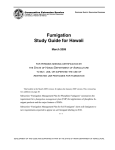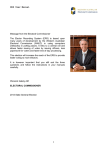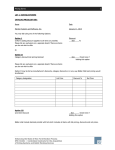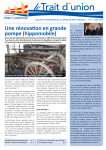Download Message from the Electoral Commissioner Congratulations on being
Transcript
Ordinary Issuing Officer Manual Message from the Electoral Commissioner Congratulations on being appointed as a Polling Official to work at a polling place on election day. As a Polling Official employed by the Western Australian Electoral Commission (the Commission), your work is crucial in the conduct of the election in the district to which you are appointed. You have a key role in the democratic process for this State electoral event. It is extremely important that you become familiar with the contents of this manual as soon as possible so that you will know where to refer when required. Please also take a few minutes to view the short training DVD attached to the cover of this manual or available for viewing via the Commission’s website at www.elections.wa.gov.au. You must not disclose any confidential elector information that you see or hear while working for the Commission; remember the need for impartiality and professionalism in your conduct. A key to the smooth running of the election is your ability to ensure that all members of the community are treated with courtesy and in accordance with electoral procedures. Warwick Gately AM ELECTORAL COMMISSIONER 2013 State General Election 114653_6.DOC 1 How to use this manual This manual is in two sections. The first section comprises checklists and the second section contains information which expands on these checklists. The checklists are for you to systematically follow to ensure that you conduct your role in this election effectively. Follow these steps and tick the boxes next to them to confirm that you have completed the instruction or undertaken the task. A page number may appear in the shaded margin to the right of each checklist (e.g. p 45). This is the page number in this manual you are to refer to if you require further explanation on how to complete a particular checklist task. Elector Recording System (ERS) The Western Australian Electoral Commission (WAEC) provides two methods for marking the elector’s name on the electoral roll prior to the issue of ballot papers: Manually marking the elector’s name on the printed electoral roll or a computerised lookup and mark off system using a netbook computer and wireless communications. This system is called Elector Recording System (ERS). Polling places selected to use ERS for ordinary vote issuing will be provided with an additional materials pack which will include a User Manual and complete setup instructions. Declaration Vote Issuing Officers will also use ERS at designated locations. All ERS polling places will have printed electoral rolls for the district, in case of the unlikely event of computer or power failure problems. All Ordinary Issuing Officers will need to fully understand the process of manually issuing votes using printed rolls. Example of printed roll OR 2 CONTENTS Checklist 1 – Induction......................................................................................................5 Checklist 2 – Election Day (arrive no later than 7.00 am)...............................................7 Checklist 3 – After Close of Poll (or as directed) ............................................................9 Polling Day – Before 8.00 am..........................................................................................11 Polling Day – 8.00 am to 6.00 pm ...................................................................................15 Polling Day – After 6.00 pm.............................................................................................23 Customer Service ............................................................................................................27 Candidates, Party Workers and Scrutineers .................................................................29 Polling Place Staff ...........................................................................................................30 3 Notes: 4 Checklist 1 – Induction Read Employee Information Booklet Complete ATO Tax File Number Declaration OR Application for Exemption from Taxation Payments Acceptance Declaration by Polling Officer Employee Payment Details Declaration by Officer Choice of Super (if applicable) Post Completed employment forms above in prepaid envelope provided View Election Staff training DVD Read This manual View (optional) Additional training “Training”) information (www.elections.wa.gov.au click on Understand Voting procedures as detailed in this manual p.15 Elector eligibility requirements p.19 5 Notes: 6 Checklist 2 – Election Day (arrive no later than 7.00 am) Before leaving home – bring with you Personal items – adequate food and drink for the day (you will not be able to leave the vicinity of the polling place), prescription glasses, medication Personal comfort items – cushion, cardigan Your Confirmation of Employment This manual Sign Attendance sheet Wear Name tag Polling Official (PP20) Setup issuing table (using items listed on pack list PP2) Process for Issuing Ordinary Votes card (PP37) Have you moved recently? Laminated A5 card (PP21) p.13 Enrol to vote or update your details form and reply paid envelopes p.13 Elector Information Report pad (PP34) p.12 Spoilt or Discarded Ballot Paper envelopes (PP36) p.14 Declaration by an elector who has applied for, but not received an Early Vote (by post) forms (PP35) p.13 Receive from Polling Place Manager Ballot Papers Electoral Roll or ERS computer p.16 Ballot Papers received (assume stapled bundles of ballot papers include the number stated) for each district and region) p.11 Count Record Quantity of ballot papers received on Electoral Roll – Account of Ordinary Ballot Papers (PP15) or Computer Users Account of Ballot Papers Received and Issued (PP64) p.11 7 Sign Electoral Roll – Account of Ordinary Ballot Papers (PP15) or (PP64) if using ERS Listen carefully Polling Place Manager briefing before polling commences If allocated the role of Ballot Box Guard or Queue Controller follow directions from Polling Place Manager. It is important to remain alert to electors requiring particular assistance. 8 p.23 Checklist 3 – After Close of Poll (or as directed) Count, then place a post-it note on top Quantity of Spoilt and Discarded Ballot Paper envelope (PP36) for Legislative Assembly Quantity of Spoilt and Discarded Ballot Paper envelope (PP36) for Legislative Council Remaining unused ballot papers for Legislative Assembly Remaining unused ballot papers for Legislative Council Complete on PP15 Total Ordinary Ballot Papers allocated (Column 4) p.23 Total Spoilt Ballot Paper envelopes (PP36) (Column 5) p.23 Total Unused Ballot Papers (Column 6) p.23 Total Ballot Papers issued to electors (Column 7) p.23 Check All Issuing Officers who have used your Electoral Roll – Account of Ordinary Ballot Papers (PP15) have signed front page as required Have ready for collection Enrol to vote or update your details forms and reply paid envelopes (separate completed and unused) Elector Information Report pad (PP34) Declaration by an elector who has applied for, but not received, an Early Ballot paper (by post) forms (PP35) Sort and count p.24 Legislative Assembly ballot paper first preferences first Legislative Assembly notional distribution second Legislative Council ticket votes and first preferences third Your Polling Place Manager will direct you to undertake various tasks during the sort and count stage Before you leave (after count and packing materials) Sign timesheet 9 Notes: 10 Polling Day – Before 8.00 am Arrival Time for Polling Staff All staff must report to the Polling Place Manager no later than 7.00 am on polling day. Your Polling Place Manager will conduct a general briefing session and allocate duties before opening the polling place at 8.00 am. Should there be anything in this manual that you are unsure about, this is an ideal time to ask any questions. General All Polling Officials are expected to be neatly dressed and should wear their polling official name tag (supplied by the Polling Place Manager) whilst on duty. Polling Officials cannot wear any badge or emblem of a political nature or clothing which has a political message. Breaks are not at fixed times but will be advised by the Polling Place Manager based on voter traffic. Any personal property that you bring with you is your own responsibility and you must ensure that it is safe and secure at all times. Mobile Phones (or other personal electronic devices) • Not to be used in the polling place. This includes checking messages, Facebook, tweeting, emails or internet. • No photographs to be taken. • No iPods (or similar devices) for listening to music – with/without earplugs/headsets. Ballot Papers The Polling Place Manager will issue each Ordinary Vote Issuing Officer with a supply of ballot papers. During the day further issues of ballot papers will be made as required. When receiving a supply of ballot papers: • count the number of each type of ballot paper received - Legislative Assembly (white) and Legislative Council (pink). • record the number of each type of ballot papers received onto the Account of Ordinary Ballot Papers (PP15) form, which is the face sheet of the electoral roll (or on PP64 if using ERS). • DO NOT transfer ballot papers between issuing points. Each polling officer must account for all ballot papers issued to them and it is your responsibility to monitor your supply of ballot papers to ensure that you have sufficient. Ballot boxes, ballot papers and electoral rolls are security items and must not be left unattended at any time. 11 Ordinary Vote Issuing Officer Materials Check that you have received everything you need. These items are detailed below. The Electoral Roll The Polling Place Manager will issue each Ordinary Vote Issuing Officer with a copy of the electoral roll for the district. It is specially printed so that it can be scanned electronically after the election. Alternatively, some officers will be issued with an ERS netbook computer. Officers using ERS should only open the paper printed roll if directed to do so by the Polling Place Manager. Ordinary Vote Issuing Officer Instruction card – PP37 Double-sided laminated card for quick and easy reference. It summarises the procedures for determining eligibility to vote and issuing ballot papers and should be kept in front of you and used at all times. Elector Information Reports – PP34 Elector Information Report (PP34) is used when the elector provides you with information regarding another elector or if there is an enrolment processing error. Use Section A of the Elector Information Report when, for example, a parent might advise you that their son is holidaying overseas and therefore cannot vote; or the elector may advise you of a recent family death. If the elector is overseas, ensure that the departure and return dates are included, even if they can only be approximate dates. Section B of the Elector Information Report is provided for the elector to request correction of an enrolment processing error. For example, their middle name is spelt incorrectly. Do not use this report for changes of address or name. Give the elector an Enrol to vote or update your details form to complete and a reply paid envelope. Complete a separate page for each report and do not remove any pages from this pad. 12 Have you moved recently? card – PP21 The Have you moved recently? laminated card is provided so electors can read about the requirements for re-enrolling after changing their address. Declaration by an elector who has applied for but not received an Early Vote (by post) ballot paper – PP35. You may receive a request for a ballot paper from an elector who has applied for, but not received, their early ballot paper by post or who has mislaid their Early Vote (by post) ballot paper voting package and now wishes to vote in-person. Before issuing the ballot paper the elector must complete a Declaration by an elector who has applied for but not received an Early Vote (by post) Ballot Paper form (PP35). Issue ballot papers in the normal manner by asking the elector the three compulsory questions and marking against their name on the roll. Inform the elector that if they receive or locate their Early Vote (by post) package it should be torn up and discarded as it is an offence to vote more than once. Refer the elector to the Declaration Vote Issuing Officers if the elector lives outside the district. Enrolment Forms An elector who is not correctly enrolled should be given an Enrol to vote or update your details form to complete and sign so that details can be correctly recorded on the roll under the Electoral Act 1907. Any amendment to the elector’s details must be signed by the elector. If the elector does not complete the form immediately, you may give them a reply paid envelope to use to return the completed and signed form. 13 Spoilt or Discarded Ballot Paper envelopes – PP36 Each Spoilt or Discarded Ballot Paper envelope must only contain one ballot paper. Spoilt Ballot Paper If the elector has made an error on their ballot paper they must give the spoilt ballot paper back to you before you can give them a new ballot paper. • Write the word ‘Spoilt’ on the back of the ballot paper. • Insert the spoilt ballot paper into a Spoilt or Discarded Ballot Paper envelope. • Issue a new ballot paper to the elector. • Complete the details on the envelope. • Seal the Spoilt or Discarded Ballot Paper envelope. • Sign and date the envelope. • Retain the sealed envelope containing the spoilt ballot paper until the close of polling. All Spoilt envelopes are to be recorded on Account of Ordinary Ballot Papers (PP15) form (or PP64 for ERS users) and, at the close of Poll, given to the Polling Place Manager. Discarded Ballot Paper Discarded ballot papers do not form part of an Issuing Officer’s reconciliation as they are already accounted for in the number of ballot papers issued. If you find a ballot paper abandoned in a voting screen or on the floor, hand it to the Polling Place Manager immediately. 14 Polling Day – 8.00 am to 6.00 pm Polling place doors will be opened at 8.00 am sharp and closed at exactly 6.00 pm. During the hours of polling, you must ensure correct procedures are being followed. Procedure for Issuing Ordinary Votes Ordinary Vote Issuing Officers are responsible for ensuring that ballot papers are issued to every elector from the district who attends the polling place and is eligible to vote. Compulsory Questions Section 119(1) of the Electoral Act 1907 requires that certain questions must be put to all electors to establish their identities and have them declare that they have not voted previously in this election. Every elector must be asked the three compulsory questions. QUESTION 1 “Have you cast an early vote for this election or already voted today?” (Some electors may have applied for an early vote) If ‘YES’ the elector is not entitled to vote again. If ‘NO’ ask the next question. QUESTION 2 “What is your full name?” QUESTION 3 “Where do you live?” (What address did you last advise the Electoral Commissioner was your permanent address?) If satisfied that the elector is entitled to vote, make the appropriate mark on the electoral roll to show the elector as having voted, then issue the elector with ballot papers. How to Find Names on the Paper Roll Electors are listed in the following order: • surname • given name 1 • given name 2 (If using a netbook, refer to the ERS user manual). EasyVote Card If the elector presents an EasyVote Card they received in the post, you are still required to ask the three questions. The page number in your electoral roll book where their name can be found is printed on the card to assist you. Asking the three questions is a legislative requirement and involves the elector making a public declaration before an electoral official. The EasyVote Card has been introduced to provide information to electors about their enrolment and to assist electoral officials with the spelling of names and the roll book page number. Nevertheless, you must still ask the three questions. 15 Indexing Conventions Used on the Roll Mac and Mc are sorted as Mac. O’ names are sorted as though the apostrophe is not there e.g. O’Neil is listed as ONEIL. Hyphenated names are sorted as though the hyphen does not exist and there is no space e.g. Forbes-Smith is sorted as FORBESSMITH. Names beginning with prefixes such as ‘de’, ‘di’ or ‘st’ are sorted as though the space between the prefix and the rest of the name does not exist e.g. di Lorenzo becomes DILORENZO, St John becomes STJOHN. How to Mark the Paper Roll (If using a netbook, refer to the ERS user manual). Handle the electoral roll carefully. Do not eat or drink with it in front of you. Make sure that the only mark you put on the roll is the line between the arrowheads. Neatly draw, in freehand, one continuous firm line between the two arrow heads beside the name. Do not use a ruler. Example Example SMITH A 1234 Before Marking SMITH A 1234 After Marking DO NOT mark the roll other than as instructed. These marks are scanned electronically after the election to check who has voted. When the roll is scanned, other marks will cause misreads of who has voted. Do not move or remove any pages. Do not crease the pages or ‘dog-ear’ the corners. 16 Correcting Mistakes on the Roll Do not use a rubber or other type of eraser. If you make a mistake and mark the wrong name: 1 Draw a firm line in the error response area in the top left-hand corner of the same page. Example ERROR 2 Write the letter ‘W’ for ‘wrong’ to the left of the incorrectly marked name, next to the elector number. Example W 1234 3 SMITH A Mark against the correct name. If the elector marked with a ‘W’ later comes to vote at your issuing table simply cross out the letter ‘W’. Issuing an Ordinary Vote Issue an ordinary vote in the following way: • detach a Legislative Assembly and a Legislative Council ballot paper from each pad. • fold the ballot papers once. • hand the ballot papers to the elector and ask the elector to: − go to a vacant voting screen − read the instructions on the ballot paper − mark the ballot papers in accordance with those instructions − put the marked ballot papers into the appropriate ballot boxes as they leave. 17 Enrolment Discrepancies Name not on the Roll If the elector lives in the district and the elector’s name cannot be found on the roll, check the following: • reversal of surname and first or given name, especially with names of non-English origin. • former name. • name before marriage. An elector may apply to vote under a previous name. • alternative surname spellings, for example Shean, Sheen. If necessary ask the elector to write down the name for you • age (if possibly under 18); explain to the person that if they are under 18 years of age, even though they may have enrolled as a provisional elector, they are only entitled to vote after reaching 18 years of age and therefore their name does not appear on the electoral roll used for this election. • check with the elector to find out if the elector enrolled prior to the close of rolls. The close of roll date is on the top of each page of the electoral roll. If enrolment was after this date, explain this to the elector. Direct the elector to the Declaration Vote Issuing Officers, as the elector may be eligible to lodge an absent vote for their previous district. If the elector’s name still can’t be found on the electoral roll, and they believe it should be listed, direct them to the Declaration Vote Issuing Officers. The elector may be entitled to a provisional vote. Name is on Electoral Roll Twice (Perhaps with minor variations) Ask if two people with the same name live at that address. Place a mark alongside only one name on the electoral roll. Do not mark both names. Record details of duplications (where 2 identical names are listed but only 1 person with that name lives at that address) in Section B of the Elector Information Report (PP34). Elector Appears to Have Already Voted If a mark has been made against the elector’s name and the elector declares that they have not previously voted in this election, direct the elector to the Declaration Vote Issuing Officers who may issue a provisional vote. 18 Different Address Check if the elector has lived at this address in the past and has moved recently. The Electoral Act 1907 requires you to re-enrol for your new permanent address when you move. The elector is entitled to an ordinary vote if they are on the roll and have lived either at the enrolled address or somewhere else within the same district in the last three months. Issue ballot papers in the normal manner by asking the elector the three compulsory questions and marking against their name on the roll. Also provide the elector with an Enrol to vote or update your details form to complete (and reply paid envelope if required). If the elector moved permanently more than three months ago to an address outside the district and has not updated their enrolment, they are no longer eligible to vote. You must: • offer the elector the Have you moved recently? (PP21) card to read and briefly explain the situation – refer to back page of your card (PP37) titled If an elector has moved to a different address. • provide the elector with an Enrol to vote or update your details form to complete and reply paid envelope. • refer the elector to the Declaration Vote Issuing Officer who may give them a provisional vote or complete a Certificate of Attendance (PP75). Address Omitted from Roll (Silent Electors) Certain electors, for security reasons, have only their names listed on the roll (silent electors). Their address is replaced by ‘Section 51B’. Ask the elector the first two compulsory questions only, then issue the ballot papers and mark against their name on the roll. General Early Voters Once registered as a General Early Voter, the elector is automatically sent ballot papers for each State election. To qualify as a General Early Voter an elector needs to either: • live more than 8 kms from the nearest polling place. • be an ill or infirm elector or a carer of such a person. • be a silent elector and apply to have their address suppressed from the electoral roll. • possess religious convictions preventing attendance at a polling place on a Saturday. • be permanently disabled. • be over the age of 70. Direct any enquires about becoming a General Early Voter to the Polling Place Manager. 19 Early Votes (by post) If the elector has a completed Early Vote (by post), and wants to hand it in, direct the person to the Polling Place Manager. Delivery of Early Votes (by post) for any district may be accepted at the polling place until 6.00 pm. If the elector has mislaid their Early Vote (by post) voting package, or applied for but not received it in the post, then they must first complete the Declaration by an elector who has applied for, but not received an Early Vote (by post) form (PP35). Issue ballot papers in the normal manner by asking the elector the three compulsory questions and making the mark against their name on the roll. Cancelling an Early Vote (by post) Should the elector with an Early Vote (by post) voting package wish to cancel their voting package and vote in-person instead, endorse the voting package ‘CANCELLED at (name of Polling Place)’ date and sign it and give it to the Polling Place Manager. Issue ballot papers in the normal manner by asking the elector the three compulsory questions and marking against their name on the roll. Requirement to Use Pencil The elector may ask whether it is necessary to use a pencil to record their vote. Tell the elector a pen may be used if they have one. Pencils are used because they are inexpensive, do not dry up when stored and can be sharpened as required. Accidents in the Polling Place Every polling place has been issued with a small first aid kit. Any accident occurring in the polling place involving staff, scrutineers or member of the public, needs to be dealt with sympathetically and professionally. If an accident to any person occurs during the course of polling: • assess the situation and provide assistance. • as soon as possible notify your Polling Place Manager. • refer witnesses to the accident to your Polling Place Manager. • the Polling Place Manager is required to complete an accident report on the Polling Place Manager General Return (PP44). Do not become involved in any discussion related to liability of parties regarding accidents. 20 Preparations for Close of Poll During the late afternoon the Polling Place Manager will instruct you to begin preparing for the close of polling. Some of the tasks are to: • make sure that you have voted. • read the instructions to be followed after the close of voting (see following pages). • check the polling place for discarded ballot papers. Close of Poll The polling place closes at 6.00 pm sharp. If there is a queue extending outside the polling place a polling official is to join the end of the queue at 6.00 pm sharp and no other electors are allowed to join the queue. Ballot boxes are not opened until all electors have voted and exited the polling place. 21 Notes: 22 Polling Day – After 6.00 pm During this period the three main tasks are: 1 that all ballot papers are accounted for. 2 the count is undertaken. 3 electoral materials are packaged for return to the Returning Officer. The polling place will be set up to conduct the counting of ordinary votes for both the Legislative Assembly and Legislative Council, which must start as soon as possible after 6.00 pm. The Polling Place Manager will direct staff on this immediately after the polling place closes. The counting of ballot papers and the packing of materials are to be completed before the Polling Place Manager releases staff. Balancing of Ballot Papers Each Ordinary Vote Issuing Officer is responsible for balancing the ballot papers issued to their issuing point. If during the day two or more officers used the same electoral roll then they are all responsible for balancing the ballot papers on the Account of Ordinary Ballot Papers (PP15) form – the face page of the paper electoral roll. Each officer must also sign the front of the electoral roll. Account of Ordinary Ballot Papers (PP15) • Total the number of Legislative Assembly (white) and Legislative Council (pink) ballot papers received at the issuing point and record these totals at column 4. • Count the spoilt ballot paper envelopes (Legislative Assembly and Legislative Council separately) and record these totals at column 5. Each envelope should contain only one ballot paper. • Count the total number of unused Legislative Assembly and Legislative Council ballot papers and record these totals at column 6. • Calculate the figures recorded at column 7 to ensure you have accounted for all the ballot papers issued. • Make sure the electoral roll is signed and dated by all staff who have used it. Under no circumstances is the front cover Account of Ordinary Ballot Papers (PP15) to be detached from the roll. 23 The Electoral Roll with the Completed PP15 Form and Unused Ballot Papers • Once you have balanced your ballot papers and completed form PP15, check each of the following and then pass them to your Polling Place Manager. • Place any Spoilt ballot paper envelopes into a bundle. • Place any Discarded ballot paper envelopes into a bundle. • Check the Elector Information Report (PP34) pad and ensure any used forms are completed correctly. • Place any completed Declaration by an elector who has applied for but not received an Early Vote (by post) ballot paper (PP35) forms into a bundle. • Separate completed and blank Enrol to vote or update your details forms into two bundles. Opening the Ballot Boxes All ballot boxes are opened by the Polling Place Manager in the presence of other polling staff and any scrutineers in attendance as soon as possible after 6.00 pm. The Polling Place Manager must check the ballot box seal(s) against the information on page 5 of the Polling Place Manager General Return (PP44) before breaking the seals. A record of this procedure must be witnessed by a scrutineer or a Polling Official. The Counts The Polling Place Manager will instruct you as to how the counts are to be conducted. Depending on the size of the polling place, a Table Supervisor will be allocated to each counting table. It is the responsibility of each Table Supervisor to ensure that the count is conducted according to the instructions of the Polling Place Manager. The basic steps for counting ballot papers are outlined below: • sort the ballot papers face up and in the same direction so that first preferences can be checked while counting. • sort the ballot papers into formal, informal and questionable. • sort the formal ballot papers according to their first preference. • the Table Supervisor will examine the questionable ballot papers and the Polling Place Manager will examine the informal ballot papers. • count formal ballot papers into bundles of 50, plus a bundle for the remainder (write the number on a post-it note). When counting ballot papers into bundles of 50, count two lots of 25 rather than 50 at once. You may prefer to use a finger stall when counting. The Table Supervisor will inform the Polling Place Manager of the number of ballot papers for each candidate’s first preference votes. There are three separate counts conducted in each polling place: 1 First preference count of white Legislative Assembly ballot papers. 2 Notional distribution of white Legislative Assembly ballot papers. 3 Ticket and first preference count of pink Legislative Council ballot papers. 24 Packing and Return of Materials and Equipment Once the counting of ballot papers has been completed and the results phoned to the Returning Officer, the Polling Place Manager will allocate final tasks to the Polling Officials, which could include: • dismantling the voting screens. • preparing the empty ballot boxes for return. • removing posters. • packing material into plastic bags according to the labels affixed to the bags. • sealing the plastic bags and recording the seal numbers on the Polling Place Manager General Return (PP44). • inspecting the premises to make sure that no election material has been overlooked. The polling place must be left in a tidy and clean condition. Any furniture that has been moved must be returned to its correct location. For security reasons, it is desirable for a Polling Official to accompany the Polling Place Manager when returning election materials to the Returning Officer. Signing the Attendance Sheet Before leaving the polling place each Polling Official must sign the attendance sheet. Advise the Polling Place Manager if you have not signed the attendance sheet. If this is overlooked your remuneration will be delayed. 25 Notes: 26 Customer Service Use your best judgement to assist every elector. Remember that you are a representative of the Western Australian Electoral Commission with a duty to abide by the Commission’s Code of Conduct and to provide excellent customer service. For one reason or another, some electors who approach you may be anxious, nervous, confused, or in a hurry. On rare occasions, your duties may be made difficult by an aggressive elector. Be polite and refer the elector to the Polling Place Manager if you think this is necessary. Do not direct an elector to vote at another polling place. The elector may ask you to discuss political issues, candidates or parties. If this occurs, politely inform the elector that your job today is to issue votes correctly, remain impartial and as such you are not able to discuss these matters. If the elector seeks information on a political party or candidate, direct them to the people issuing ‘how-to-vote’ cards outside the polling place. The elector cannot take the ballot papers outside the polling place. The ballot papers may be left with the issuing officer until the elector returns. Cardboard voting screens are not designed to bear large weights; ensure that electors carrying babies or small children are warned of this fact and do not put themselves or others at risk. Enhancing Access to Voting All eligible electors are entitled to actively participate in our democracy by voting. However, some electors who attend your polling place may require assistance to vote. The following provides instructions for assisting such electors. Electors with Impaired Hearing Refer to the Hard of Hearing counter card at the polling place. Communication with electors with impaired hearing is easier if you: • directly face the elector and ensure your face is not in shadow. • keep hands and hair away from your face, with your lips clearly in their view. • speak clearly at a moderate speed. • do not shout. • use plain language and get to the point. • avoid unnecessary words. • rephrase or write down questions. At this election a small number of polling places will be trialling Hearing Loop technology. Refer to the associated instructions if this applies to your polling place. 27 Electors Needing Assistance with Writing If the elector is illiterate, visually impaired or disabled, or has limited knowledge of English, they are entitled to receive help with voting. Direct the elector to your Polling Place Manager. The Polling Place Manager may assist the elector in completing the ballot paper in the presence of a scrutineer or if a scrutineer is unavailable, in the presence of a person nominated by the elector, or a polling official. Electors with Walking Difficulties If the elector is too incapacitated to enter the polling place, but is able to come near the polling place, the Polling Place Manager can organise for ballot papers to be taken to the elector. This may be to a motor vehicle parked near the polling place. The Queue Controller is responsible for ensuring that electors who have difficulty walking or are frail do not have to stand in a queue. Let electors know that the tabletop voting screen is available if they wish to sit down to cast their vote. If additional assistance is required advise the Polling Place Manager. Electors Unfamiliar with English These electors should be provided with the Multilingual Guide to help in determining the appropriate language. The Multilingual Guide has how-to-vote information in a number of different languages. If they fail to recognise one of those languages direct the elector to the Polling Place Manager who may have access to the Commonwealth Telephone Interpreting Service. If the elector has their EasyVote card, this can be used to check the spelling of name and address details and to identify the relevant page number in the printed electoral roll. 28 Candidates, Party Workers and Scrutineers Candidates, party workers and scrutineers have different rights and responsibilities at the polling place. Candidates Candidates are not allowed to take part directly in the conduct of the election. They may not be scrutineers and may not enter a polling place except to record their own vote and must not be wearing campaign t-shirts or badges when they do so. Party Workers Party workers distribute ‘how-to-vote’ cards for candidates usually near the entrance of a polling place. Party workers may only enter the polling place to record their own vote. Scrutineers Scrutineers represent the candidates in the polling place to help ensure that the election is seen to be free and fair. They are free to observe all the operations of the polling place and play an important role in the electoral process. Scrutineers must wear the Scrutineer name tag provided by the Returning Officer or Polling Place Manager. Role of Scrutineers Scrutineers may: • inspect (but not touch) all ballot boxes and witness their closing, sealing and opening. • make queries about the electoral processes to the Polling Place Manager. • observe the operation of polling within a polling place and its surrounds. • request the Polling Place Manager to arrange a provisional vote for an ordinary elector. • observe the Polling Place Manager or an Issuing Officer assisting an elector who needs help. • observe the conduct of the count after the close of polling. • challenge the formality of a ballot paper at a count. However, the Polling Place Manager will make the final decision on the formality of a ballot paper. Scrutineers may NOT: • touch ballot papers or declaration envelopes. • help with the clearing of screens or in the removal of material from the polling place. • wear a badge or emblem of a party or candidate in a polling place. • communicate with any person in a polling place except in the performance of their specific duties as scrutineers. 29 Polling Place Staff A number of Polling Officials are appointed to each polling place and their duties are outlined below. It is useful for you to have an understanding of the duties of the entire team. Ordinary Vote Issuing Officer (OIO) The duties of the Ordinary Vote Issuing Officer are to: • count and record the number of ballot papers received on Account of Ordinary Ballot Papers (PP15), which is the face sheet of the electoral roll. • ask every elector the three compulsory questions. • determine the eligibility of ordinary electors. • direct potential absent and provisional voters to Declaration Vote Issuing Officers. • put a mark against eligible electors’ names on the electoral roll. • issue ballot papers to eligible electors. • if required, provide the Multilingual Guide. • direct each eligible elector to a vacant voting screen. • complete the Elector Information Report (PP34) when the elector provides information. • provide electors, whose details have changed, with an Enrol to vote or update your details form and a reply paid envelope. After polling closes at 6.00 pm: • record the total number of ballot papers issued on the front page of the electoral roll Account of Ordinary Ballot Papers (PP15). • sign the electoral roll (PP15). • assist with sorting and counting ordinary ballot papers as directed. • assist in packing up materials. • witness the recording and sealing of security bags. • assist with the final tasks of dismantling voting screens. • prepare empty ballot boxes for return. • follow any further instructions as received from the Polling Place Manager. Polling Place Manager (PPM) A Polling Place Manager is appointed to each polling place and is responsible for: • overall supervision. • operation of the polling place and polling staff. • liaising with key stakeholders such as scrutineers and campaign workers. • managing the count and ringing through results to the Returning Officer. A Substitute Polling Place Manager will be appointed should the Polling Place Manager leave the polling place at any time during voting. 30 Assistant Polling Place Manager (APPM) An Assistant Polling Place Manager is appointed where polling places have four or more ordinary vote issuing points. The role of the Assistant Polling Place Manager is to assist in the operation and supervision of the polling place and to act as the Polling Place Manager if required. Declaration Vote Issuing Officer (DIO) In certain circumstances, the elector is required to make a declaration before they can vote. These electors should be referred to the Declaration Vote Issuing Officers. This is required when: • the elector is absent from their enrolled electoral district on polling day and attends to vote at a polling place in another district (absent vote). • the elector’s name cannot be found on the electoral roll (provisional vote). • the elector’s name has already been crossed off the electoral roll (provisional vote). • the elector’s claim to vote is challenged by a scrutineer (provisional vote). A separate manual is provided for Declaration Vote Issuing Officers. Ballot Box Guard (BBG) The duties of a Ballot Box Guard are to: • be responsible for the security of the ballot boxes and maintain a watch over ballot boxes throughout the hours of polling. • ensure all electors place their ballot papers in the correct ballot box before leaving the polling place. • assist with sorting and counting ordinary ballot papers. • assist with the final tasks of dismantling voting screens and ballot boxes. • follow any further instructions as received from the Polling Place Manager. Queue Controller (only appointed at larger polling places) The duties of a Queue Controller are to: • ensure a smooth flow of electors to issuing points as they become vacant. • keep queues in reasonable order. • ensure voting screens and their immediate area are kept tidy and clear of any election material, and pencils are regularly sharpened. • prioritise electors who require assistance, e.g. disabled or elderly electors. • identify declaration voters and direct them to the appropriate issuing officer. • identify family groups and direct electors with the same family name to the same issuing point. 31 • advise the Polling Place Manager if electors are waiting more than five minutes to vote. • assist with sorting and counting ordinary ballot papers. • assist with the final tasks of dismantling voting screens and ballot boxes. • follow any further instructions as received from the Polling Place Manager. General Assistant (only appointed at larger polling places) A General Assistant works from 5.30 pm to assist with dismantling the polling place and the count of ordinary ballot papers. A General Assistant may also be employed after the election to assist the Returning Officer. Rotation of Staff Polling officials, other than Declaration Vote Issuing Officers, are normally rotated between positions to help them remain fresh and alert. Ordinary Vote Issuing Officers can be rotated with the Ballot Box Guard and the Queue Controller. If workload permits, Ordinary Vote Issuing Officers may be given the opportunity to observe declaration vote procedures. Ordinary Vote Issuing Officers, however, must not issue declaration votes unless fully trained to do so. 32















































